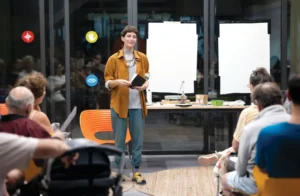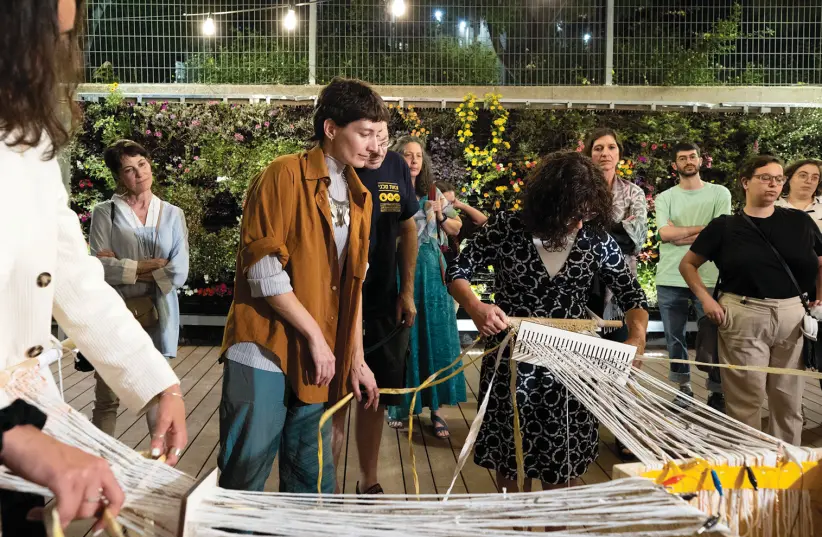The Jerusalem International Fellows program brings artists and performers to engage with the capital’s eastern and western sides.
“It’s not about finishing a painting,” says Elise Bernhardt, founder and director of Jerusalem International Fellows. “It is not about finishing your symphony. It’s about engaging through culture.”
The Jerusalem International Fellows program is a 10-week residency program that brings performing artists, choreographers, visual artists and urban planners from around the world to Israel to engage and collaborate with independent artists, ensembles and cultural institutions in east and west Jerusalem.
“We are looking for two things,” says Bernhardt about the type of fellows she seeks. “We are looking for people with demonstrated expertise in their artistic field – individuals with real talent – but also people who are really interested in engaging with other people. That is critical to the whole enterprise – that people are learning from other people, teaching others and developing networks.”
Bernhardt adds that the artists, through both their work and their ability to communicate, can bridge gaps between east and west Jerusalem. “There is a kind of cultural diplomacy. I do see that little connections are being made across the city’s seam, and I think it’s because artists are able to do that in a way that no one else can. They have this ability because of what they do and how they do it. At the end of the day, they are making inroads.”
The program’s pilot residency began in March of this year, bringing four artists from around the world – Sofia Borges, a visual artist from São Paulo, Brazil; Vibha Galhotra, a conceptual artist from New Delhi; Claudia Lavista, a choreographer, dancer and professor of contemporary dance, from Mazatlán, México; and Anna Lublina, an interdisciplinary performer, from New York.

Each artist spent time at a specific location in Jerusalem, where they showed and displayed their work. Borges was hosted by the Idbaa School for the Arts, the first of its kind in the Arab sector, located in Sheikh Jarrah. Galhotra was based at Muslala, a nonprofit organization located in the rooftop gallery of the Clal Building; Lavista was hosted at the c.a.t.a.m.o.n Dance Group, a performance organization located in the Alliance House, near the Mahaneh Yehuda market, while Lublina exhibited her work at the Bloomfield Science Museum.
Throughout their stay in Jerusalem, the four artists have been living together in an apartment in Musrara and have received an in-depth introduction to Jerusalem’s cultural landscape while building their specific projects and touring the city.
IN JERUSALEM spoke with Lublina, who described her approach to art, and what she has learned from her experiences in Israel. Born in California to a family from the former Soviet Union, Lublina grew up in Irvine, California. She lived in New York from 2015 to 2021 and moved to Germany a year ago, where she has been studying for a master’s degree in choreography and performance.
Lublina, who has an extensive background in theater, says that she is a “performance maker.” “I believe in live performance and live experience with the audience, and people in a room experiencing something together. There is nothing that beats the improvisation that happens through liveness. When things go wrong, or you make a mistake, the impulse to generate something immediately within the art form is generative and human. It brings art beyond the representational for me. It becomes real. These are real people with real experiences, and not representing experiences.”
In Lublina’s view, performance can reframe meaning, shape perspective and offer new understandings. One example is her use of bread in her performance work, illustrating the different cultural and religious meanings that are associated with it, as well as the biology in the fermentation of sourdough bread and the way that people’s bodies enter that fermentation to create it, and how the bread’s microbacteria join the skin.
“There is a leaking of bodies between my body and the bread’s body,” says Lublina, “and I was exploring this through performative lecture and choreography, moving and dancing with dough. By seeing this everyday object, we feel that we have a relationship with it in a completely different context, and it expands the way we relate to these things. It’s not just something we eat, but it’s something we’re building with our own biology – it’s building us. There are mutual relationships in the environment.”
Lublina presented a work at the Bloomfield Museum on the subject of synchronicity through weaving and created a machine that takes the touch of the shuttle on the threads to make sounds produced by a singer. Several weavers are connected, each with their own rhythm. During her stay in Israel, she has been working with a neuroscience lab at the Hebrew University to understand the somatic experience of having one’s own body rhythm synchronize with other body rhythms or other rhythms of different objects.
“It has been fascinating, working with synchronization and the neurological effects of crafting together, weaving together and singing together, and how it creates synchronicity that can increase collaboration or communication,” she says.
Lublina has enjoyed working with scientists and researchers at the university science lab – she once again invokes “super,” her favorite adjective – in two disciplines and seeing how they are linked.
Beyond the positive effects of synchronicity, Lublina says that it can also be used as a tool in fascist regimes to unify people and reduce their critical thinking and individuality.
FOR LUBLINA, the only Jewish member of the quartet of fellows, her visit has been a fascinating experience.
“This is my first time in Israel,” she reports. “It has been really interesting and very different than I expected. Coming from New York, I thought I could handle a lot of tension and chaos. I have been continuously surprised both by the amazing wisdom and warmth of the people, but also how heavy it is, and that the tensions can get to you. I’ve found that I’ve been angrier here than I have been in years. It gets to you. At the same time, it’s incredible how diverse it is and transparent it is about the complexity. It doesn’t try to sweep it under the rug, and I really like that.”
Initially, Lublina did not want to come to Israel. “I was disinterested in coming here,” she says. Her family had moved to the United States, and she had no family here. She had been under the impression that Israel was a place that made Jewish culture into one monolithic whole. “As a child of immigrants, I hated the way that American Jews tried to assimilate our culture into their culture. I wanted to maintain my specificity of cultural heritage.”
Lublina quickly learned that Israel is a mosaic of different cultures, where each one retains its individual identity.
“It is so much more diverse than it could be expected,” she relates. “It’s been a true joy. I’ve never met this many types of Jews in my life – it is amazing. Especially among the younger people, so many are reaching back to special practices from where their families come from and integrating them into their artistic practice. I feel super connected to that. That’s been a nice surprise and a new way of seeing this place.”
She reports that the feedback on her work here has been quite positive and supportive, as Jerusalemites have not seen much of international artists since the pandemic began. “More than I’ve expected, people have been super curious to hear the perspective of outsiders. I think it’s very refreshing. I didn’t expect it, but people are really curious about how I am imagining seeing the world here.”
Lublina has met many artists at the various salons and sessions that the visiting artists have conducted.
“It has been amazing to exchange ideas,” she says. “I use a lot of Jewish themes in my work, and it is interesting to see how people are working with Jewish themes here. I work a lot with the idea of the Diaspora, and it has been interesting to see how people work here. It has been really enlightening.”
Lublina says that her visit to Israel has greatly expanded her vision and understanding. “What I’ve learned here will take a long time to reflect upon and recognize. I don’t think I know a quarter of how this experience will change me now than I will in two months.
“I am moving toward something more spiritual in my work, and being here feeds that desire. There is a strong magical spirit here through the history, and this definitely influences me. I’m thinking about beauty in a new way. When you frame it through the spiritual and through the soul, it means something very different to be beautiful and have something awesome, which is something new that I am working with.”
Smiling, she says that her visit has affected her on a personal level as well. “This is the first time I’m not a minority. It’s the first time I’ve experienced a lot of things. I don’t know what the effect will be.”
As for Jerusalem, Lublina speaks of her affinity for the Old City and says, with a smile, “It’s so unique! It’s an 8,000-year-old city. How can you find something else like that – so special?” Super indeed. ❖

